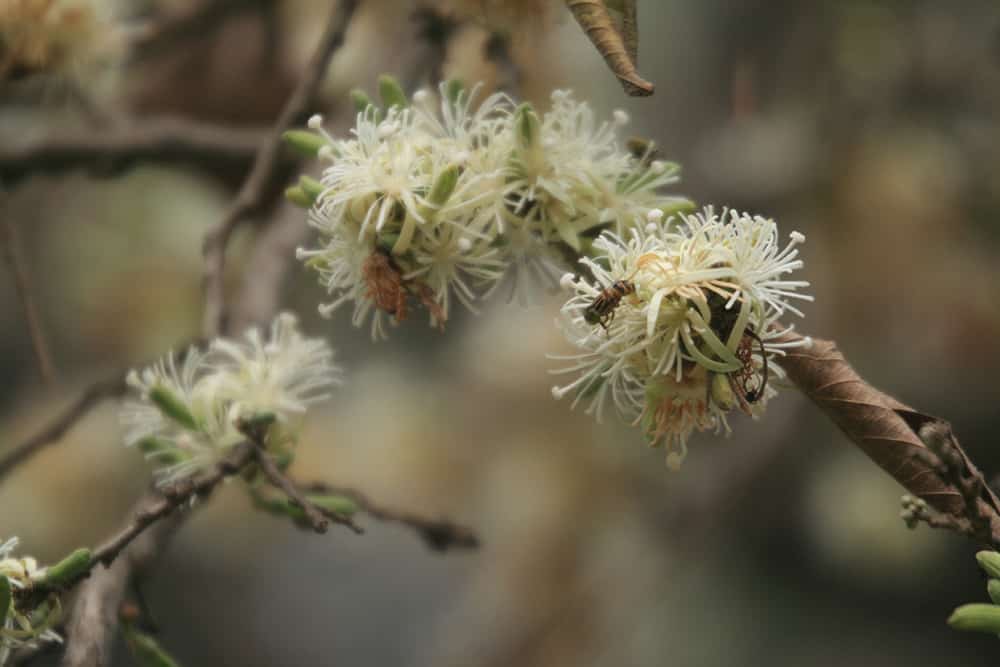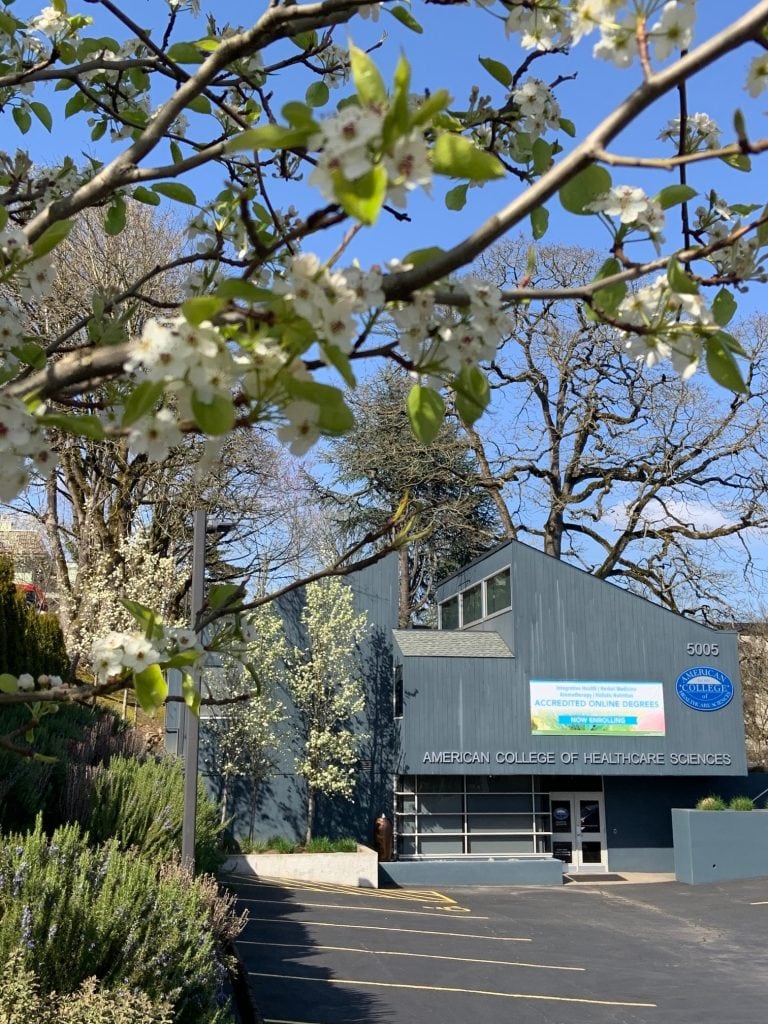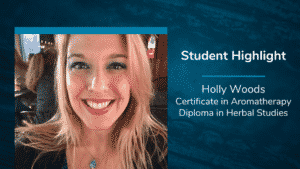
By Kathy Sadowski, MS in Aromatherapy, RA, LMT
This article originally appeared in the NAHA Journal (Summer, 2021) and it is republished here according to the NAHA Writer Guidelines 2021 copyright statement.
Has your well-trained aromatherapy nose ever had a difficult time identifying the lemon-scented species in an essential oil blend? There are a variety of lemony botanical aromas. Three delightfully lemon-scented essential oils are extracted from non-lemon plants of Australasian origin. These include lemon-scented eucalyptus (Corymbia citriodora), lemon myrtle (Backhousia citriodora), and lemongrass (Cymbopogon flexuosus).
Lemon Scented Eucalyptus

Botanical Name: Corymbia citriodora
Family: Myrtaceae
Extraction Method: Steam distilled
Plant Parts: Leaves and branches
Country of Origin: Australia, China, India, Madagascar, Ethiopia, Brazil 1
Key Constituents: Citronellal and citronellol
Aroma: Refreshingly lemony and citronella-like
Aroma Note: Top
Aroma Strength: Medium
Blends Well With: Cedarwood (Juniperus virginiana), grapefruit (Citrus paradisi), lavender (Lavandula angustifolia), palmarosa (Cymbopogon martini), petitgrain (Citrus aurantium var. amara), rose geranium (Pelargonium graveolens), and spearmint (Mentha spicata)
Possible Uses: Insect repelling, air freshening, and mood-bosting
Contraindications: Oxidized oils can cause skin irritation.
Scientific Research
- Constituents of citronellal and citronellol have demonstrated possible insect repelling activities. 2
- Citronellal and citronellol have shown analgesic activities in vitro and in vivo; more research is needed to determine a safe and effective use for humans. 3
- Citronellal was sedative in mice. 4
Lemon Myrtle

Botanical Name: Backhousia citriodora
Family: Myrtaceae
Extraction Method: Steam distilled
Plant Parts: Leaves and branches
Country of Origin: Australia
Key Constituents: Geranial and neral
Aroma: Sweet and lemony
Aroma Note: Top
Aroma Strength: Strong
Blends Well With: Bergamot (Citrus bergamia), cypress (Cupressus sempervirens), juniper berry (Juniperus communis), lavender (Lavandula angustifolia), orange (Citrus sinensis), and rose geranium (Pelargonium graveolens)
Possible Uses: Uplifting, may help open breathing, possibly a topical antiviral, and for possible food spoilage reduction related to an antimicrobial action.
Contraindications: Avoid with pregnant or nursing women and young children. Possible drug interactions. Avoid topical use with sensitive skin. Dilute the essential oil to at least 0.7% to avoid skin irritation. 1 This equals about 3 single drops of essential oil per ounce of carrier oil.
Scientific Research
- A preliminary human study showed reduction in the sexually transmitted Molluscum contagiosum virus with topical use in children and young adults. 5
- Backhousia citriodora demonstrated antibacterial and antifungal against food spoilage microbes. 6
Lemongrass

Botanical Name: Cymbopogon flexuosus or Cymbopogon citratus
Family: Poaceae
Extraction Method: Steam distilled
Plant Parts: Leaves
Country of Origin: India
Key Constituents: Geranial and neral
Aroma: Strong lemon and slightly herbaceous scent
Aroma Note: Top
Aroma Strength: Strong
Blends Well With: Basil (Ocimum basilicum), bergamot (Citrus bergamia), cedarwood (Juniperus virginiana), ginger (Zingiber officinale), grapefruit (Citrus paradisi), and vetiver (Vetiveria zizanioides)
Possible Uses: Air-freshening, insect repelling, antimicrobial, respiratory aid, analgesic, anti-dandruff, anxiolytic, anti-depressive, cognition-enhancing, and possibly for fever
Contraindications: Avoid with pregnant or nursing women and young children. Possible drug interactions. Avoid topical use with sensitive skin. Dilute the essential oil to at least 0.7% to avoid skin irritation. 1 This equals about 3 single drops of essential oil per ounce of carrier oil.
Scientific Research
- In a mega analysis of insect repelling essential oils, lemongrass was effective in multiple studies. 7
- Lemongrass has shown antimicrobial activities against antibiotic-resistant microbes. More research is needed. 8
- Lemongrass aroma may aid in respiratory infections related to its possible fungitoxic activity against the Aspergillus that cause respiratory infections. Human research is needed. 9
- Lemongrass essential oil may help reduce foot fungus in heated footbath water. 10
- Lemongrass has demonstrated in vitro and in vivo analgesic activities in studies. More research is needed to determine the safe and effective uses for humans. 11
- In a small human study with 30 people having dandruff, a hair product containing 10% lemongrass used for 14 days reduced dandruff significantly without any reported scalp irritation. More human studies are needed to determine safety and effectiveness. 12
- In a single blind parallel study with 60 healthy women, those who breathed a blend of lemongrass ( citratus), patchouli (Pogostemon cablin), and ylang ylang (Cananga odorata) demonstrated reduced blood pressure and anxiety compared to the control group. 13
- Cognitive performance improved in a small study with 30 women who inhaled lemongrass aroma. 14
- Lemongrass has been recorded as a common folk remedy for fever reduction. 15
In Conclusion…
Lemon scented eucalyptus, lemon myrtle, and lemongrass all have a surprisingly sunshine-lemon scent that is sure to boost mood, freshen the air, and may offer additional possible benefits. The laundry cleaning recipe included in this article is sure to be a favorite!
Recipe
Lemony Laundry Refresher
Description: Naturally freshen the laundry or pre-treat stains with this lemony-scented recipe.
Ingredients:
- 1 teaspoon of lemon scented eucalyptus (Corymbia citriodora) essential oil
- 1 teaspoon of lemongrass (Cymbopogon flexuosus) essential oil
- 2 teaspoons of Dawn brand dish soap
- 1 cups of white vinegar
- 1 cup of hydrogen peroxide
- 1 cups of water
Instructions:
- Wear gloves.
- In a 4-cup pyrex measuring cup, mix the essential oils and dish detergent together using a spoon.
- Then, pour in the vinegar, hydrogen peroxide, and water, and mix with the spoon. Pour into a pourable glass container with a sealing lid. Shake well.
- Label the container with the ingredients, date made, and To Use instructions listed below.
To Use: Pour 1/3 cup into your cloths washer’s “bleach” dispenser for a fresh clean scent. To treat a stain, spray a small amount directly onto the stained cloth. Then wash the clothes in your washing machine.
Caution: Hydrogen peroxide can cause bleaching / whitening to colored fabrics. Rinse clothes well. Lemongrass essential oil is a possible skin irritant. Discontinue use if any irritations occur.
Disclaimer: This article is for informational purposes only. It is not intended to treat, diagnose, cure, or prevent disease. This article has not been reviewed by the FDA. Always consult with your primary care physician or naturopathic doctor before making any significant changes to your health and wellness routine.References
- Tisserand, R. & Young, R. (2014). Essential Oil Safety. Second Edition. Churchill Livingstone Elsevier.
- Nerio, L., Olivero-Verbel, J., & Stashenko, E. (2010). Repellent activity of essential oils: a review. Bioresource technology, 101(1), 372-378.
- Lima, T., da Nóbrega, F., de Brito, A., & de Sousa, D. (2017). Analgesic-like activity of essential oil constituents: an update. International journal of molecular sciences, 18(12), 2392.
- Jäger, W., Buchbauer, G., Jirovetz, L., Dietrich, H., & Plank, C. (1992). Evidence of the sedative effect of neroli oil, citronellal and phenylethyl acetate on mice. Journal of Essential Oil Research, 4(4), 387-394.
- Wilkinson, J., Hipwell, M., Ryan, T., & Cavanagh, H. (2003). Bioactivity of Backhousia citriodora: antibacterial and antifungal activity. Journal of Agricultural and Food Chemistry, 51(1), 76-81.
- Burke, B., Baillie, J., & Olson, R. (2004). Essential oil of Australian lemon myrtle (Backhousia citriodora) in the treatment of molluscum contagiosum in children. Biomedicine & pharmacotherapy, 58(4), 245-247.
- Nerio, L., Olivero-Verbel, J., & Stashenko, E. (2010). Repellent activity of essential oils: a review. Bioresource technology, 101(1), 372-378.
- Yang, S., et al. (2018). Plant-Derived Antimicrobials: Insights into Mitigation of Antimicrobial Resistance. Records of Natural Products, 12(4).
- Al Yousef, S. (2013). Antifungal activity of volatiles from lemongrass (Cymbopogon citratus) and peppermint (Mentha piperita) oils against some respiratory pathogenic species of Aspergillus. Int J Curr Microbiol App Sci, 2(6), 261-72.
- Inouye, S., Uchida, K., Nishiyama, Y., Hasumi, Y., Yamaguchi, H., & Abe, S. (2007). Combined effect of heat, essential oils and salt on the fungicidal activity against Trichophyton mentagrophytes in foot bath. Nippon Ishinkin Gakkai Zasshi, 48(1), 27-36.
- Natural Medicines (2018). Lemongrass Monograph. Retrieved in July, 2016. Retrieved from www.naturalmedicines.com
- Chaisripipat, W., Lourith, N., & Kanlayavattanakul, M. (2015). Anti-dandruff hair tonic containing lemongrass (Cymbopogon flexuosus) oil. Complementary Medicine Research, 22(4), 226-229.
- Siahaan, R., Rahardjo, T. B., & Ranti, A. (2015). Effectiveness of Indonesian Essential Oil Mixture of Lemongrass, Cananga, and Patchouli in Relaxation through Inhalation: A Clinical Test on Healthy Woman with High Potential for Stress. Makara Journal of Health Research, 143-151.
- Sriraksa, N., Kaewwongse, M., Phachonpai, W., & Hawiset, T. (2018). Effects of Lemongrass (Cymbopogon citratus) Essential Oil Inhalation on Cognitive Performance and Mood in Healthy Women. Thai Pharmaceutical and Health Science Journal, 13(2), 80-88.
- Natural Medicines (2018). Lemongrass Monograph. Retrieved in May, 2021. Retrieved from www.naturalmedicines.com
About Kathy Sadoswki:
Kathy Sadowski has a Master of Science degree in Aromatherapy from the American College of Healthcare Sciences. With a passion for reading scientific studies on herbs and essential oils, she has developed the website www.EarthtoKathy.com, which categorizes 4,000 plus scientific research articles on plants by species, therapeutic action, and constituent. The goal is to demonstrate a growing amount of evidence for the potential healthful uses of herbs and essential oils. Kathy is a professional member of NAHA and AIA, a Registered Aromatherapist (ARC), licensed massage therapist, and enthusiast for environmental protection and a natural lifestyle. Visit Kathy’s website at: www.EarthtoKathy.com
About American College of Healthcare Sciences
 American College founded in 1978, is a fully online accredited institute of higher education specializing in holistic health. Based in Portland, OR; our goal is to make research-driven and science-based holistic health education taught by industry-leading experts accessible to anyone anywhere while still giving students a hands-on experiential learning experience like a traditional college and a strong sense of community, school pride and student bond.
American College founded in 1978, is a fully online accredited institute of higher education specializing in holistic health. Based in Portland, OR; our goal is to make research-driven and science-based holistic health education taught by industry-leading experts accessible to anyone anywhere while still giving students a hands-on experiential learning experience like a traditional college and a strong sense of community, school pride and student bond.
This commitment to our students and graduates reflects in our current survey results that reflect 98% of our students would recommend ACHS to a friend or family member.
We believe education is the most powerful tool for changing an individual and the world around us.
When a person enrolls as ACHS, it is vitally important that they graduate with tools they need to forge their own holistic and sustainable missions, build up their communities confidently and changing the face of healthcare with knowledge.
 President’s Message: End Of Year Reflectionsby American College of Healthcare Sciences●December 31, 2020
President’s Message: End Of Year Reflectionsby American College of Healthcare Sciences●December 31, 2020 Student Highlight: Wife and Husband Team Start New Businessby American College of Healthcare Sciences●December 22, 2020
Student Highlight: Wife and Husband Team Start New Businessby American College of Healthcare Sciences●December 22, 2020 Student Highlight: Holistic Health, Gratitude, and Smoothies |achs.eduby American College of Healthcare Sciences●December 17, 2020
Student Highlight: Holistic Health, Gratitude, and Smoothies |achs.eduby American College of Healthcare Sciences●December 17, 2020 3 Tips For Building Better Habitsby American College of Healthcare Sciences●December 10, 2020
3 Tips For Building Better Habitsby American College of Healthcare Sciences●December 10, 2020
